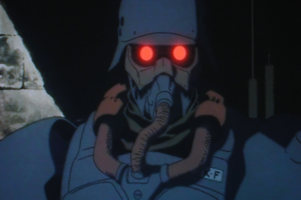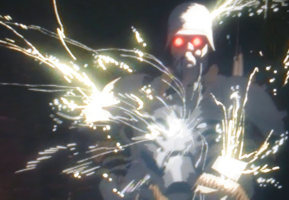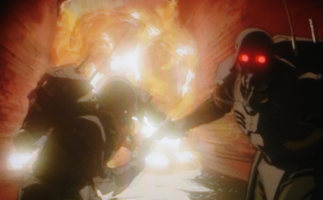JIN-ROH:
THE WOLF BRIGADE [1999]
Flash Gordon
(Anime Corner Staff Writer)
Pioneer Elite Plasma Display System PDP-5050SX
Denon AV Surround Receiver AVR-1801 with Dolby Digital/ DTS
Boston Acoustics Micro90T Die-Cast Surround Speakers including Subwoofer
Toshiba DVD SD-3755 Player with Dolby Digital/ DTS/ 3D Surround Sound.
MOTION PICTURE
16+ RATING
B- ANIMATION
C+ CHARACTER
A- MECH DESIGN
B- MUSIC
B STORY
B FILM GRADE
STUDIO: PRODUCTION I.G.
DIRECTOR: HIROYUKI OKIURA
PRODUCER: TSUTOMU SUGITA/ HIDEKAZU TERAKAWA
ANIMATOR: TETSUYA NISHIO/ KENJI KAMIYAMA
DESIGNS: HIROYUKI OKIURA/ TETSUYA NISHIO [character]/ TADASHI HIRAMATSU [mechanical/ vehicle]/ KAZUCHIKA KISE [weapons]/ HIROMASA OGURA [art]
SCRIPT: MAMORU OSHII
MUSIC: HAJIME MIZOGUCHI
THEME SONG: GABRIELA ROBIN
DVD EXTRAS: ENGLISH DOLBY DIGITAL 5.1/ JAPANESE DOLBY DIGITAL DTS 5.1/ WIDESCREEN/ [SPECIAL EDTION ONLY EXTRAS:] CD SOUNDTRACK/ INTERVIEW FEATURETTE [38 min]/ TRAILERS/ ART GALLERY/ 14 PAGE BOOKLET
|
| REVIEW (Warning:
Spoilers Ahead!) |
It’s easy to see why Production I.G. would become a shining example of a company to behold in the world of animation based upon the many talented faces that populate the credits of Jin-Roh: The Wolf Brigade. While in its infancy, the film clearly illustrates Production I.G. as a studio on the verge. While the film is imperfect, it is an artful achievement just the same. The beautiful animation is a precursor of much greater things to come. The violent, compelling story is ample evidence of the heady and provocative talent behind this upstart company. The core cadre of writer/director/art director behind this tale are the very same that would catapult films like Ghost In The Shell [1995] and Patlabor 2 [1993], which may explain why this determined project might be too smart for its own good.
The fictional story unfolds during an alternate timeline in Japan’s history. Following the Great War, Japan became immersed in a communist-style, totalitarian-like police state. The tale centers on two opposing forces in a tumultuous modern day Tokyo. First, due to restrictions imposed by the occupation of Japan on organized police or military, only the Capital can create a paramilitary force under the direct command of the National Security Committee. Inevitably, as only political power would have it, the Capital Police organization expanded its powers and
 anointed itself as guardian of the public order. Within this government regime is a shadowy, covert, special core unit of the Capital Police, legend has it, called Jin-Roh. The ultra-secret operation allegedly works outside the scope of the government’s full approval and absolute usurpation. The section’s dark uniforms and Nazi-German-styled helmets complete with glowing red eyes are utterly disturbing in their cold, unnerving and penetrating gaze. It is the face of evil for a calculated military-police state. Second, the burgeoning civil unrest has created an undercurrent of discontent through the formation of an anti-government rebel movement. This amorphous body gives rise to the evolution of a smaller, more extremist, hard-line and unyielding guerilla-terrorist operation dubbed The Sect. These two forces are at odds and at war with little resolve in sight. Despite being marginalized from the rest of normal society, the movements had slowly altered the landscape into an urban nightmare. The people becoming more and more united yearn for the demise of the special terror unit, Jin-Roh, and the breeding of riots grows. The line is purposefully ambiguous regarding who the real enemy is here. The set-up makes for a delicious recipe of suspense and mystery. Jin-Roh is written by the diffuse conundrum that is Mamoru Oshii and is penned in typically thought-provoking fashion. It is also loosely based upon elements merged from two of Oshii’s live-action films, The Red Spectacles [1986] and Stray Dog [1991] [source of the penetrating red eyes]. Political chess games and conspiracy are the order of the day in Jin Roh: The Wolf Brigade leaving most viewers a little confused as the story unfolds, but intrigued.
anointed itself as guardian of the public order. Within this government regime is a shadowy, covert, special core unit of the Capital Police, legend has it, called Jin-Roh. The ultra-secret operation allegedly works outside the scope of the government’s full approval and absolute usurpation. The section’s dark uniforms and Nazi-German-styled helmets complete with glowing red eyes are utterly disturbing in their cold, unnerving and penetrating gaze. It is the face of evil for a calculated military-police state. Second, the burgeoning civil unrest has created an undercurrent of discontent through the formation of an anti-government rebel movement. This amorphous body gives rise to the evolution of a smaller, more extremist, hard-line and unyielding guerilla-terrorist operation dubbed The Sect. These two forces are at odds and at war with little resolve in sight. Despite being marginalized from the rest of normal society, the movements had slowly altered the landscape into an urban nightmare. The people becoming more and more united yearn for the demise of the special terror unit, Jin-Roh, and the breeding of riots grows. The line is purposefully ambiguous regarding who the real enemy is here. The set-up makes for a delicious recipe of suspense and mystery. Jin-Roh is written by the diffuse conundrum that is Mamoru Oshii and is penned in typically thought-provoking fashion. It is also loosely based upon elements merged from two of Oshii’s live-action films, The Red Spectacles [1986] and Stray Dog [1991] [source of the penetrating red eyes]. Political chess games and conspiracy are the order of the day in Jin Roh: The Wolf Brigade leaving most viewers a little confused as the story unfolds, but intrigued.
Those seeking action have come to the wrong place obviously misled by the film’s promotional material. Any fan of Oshii understands his modus operandi and respects his literary, narrative approach to filmmaking. Oshii is a student of the written word and real scriptwriting and less inclined to see his cellular babies spiral into unnecessary violence for spectacle’s sake. If you’re not thinking about the work before your very eyes he’s created, then he’s failed you. That said, still, there are some stirring animation sequences spotlighting the impressive, unrelenting firepower of Jin-Roh. The beginning and end highlight powerful moments of human pain coupled with graphic, bloody violence. The intense manhunts sandwich the otherwise contemplative thriller.
One sequence is profound as a female suicide bomber from The Sect, known as a Red Riding Hood, is backed into a corner by Jin-Roh in the underground sewers. It’s animated in slow motion in front of a wolf-brigade constable named Kazuki Fuse. The rookie constable hesitates, unable to pull the trigger and dispatch her life, instead asking her quizzically “why?” just
 before the whole thing ignites engulfing the brigade in flames. Thanks to heavily fortified armor and facemasks, all survive. Constable Fuse is from the 2nd Company, Straight Platoon 3, Special Armored Brigade, Capital Police organization and quickly comes under suspicion and under fire for his inability to act on the insurgent [The Sect utilizing women and children as delivery systems mirrors today’s headlines]. Fuse had the chance to shoot and kill before the satchel bomb was triggered, leaving the viewer, along with his wolf brigade colleagues, asking questions.
before the whole thing ignites engulfing the brigade in flames. Thanks to heavily fortified armor and facemasks, all survive. Constable Fuse is from the 2nd Company, Straight Platoon 3, Special Armored Brigade, Capital Police organization and quickly comes under suspicion and under fire for his inability to act on the insurgent [The Sect utilizing women and children as delivery systems mirrors today’s headlines]. Fuse had the chance to shoot and kill before the satchel bomb was triggered, leaving the viewer, along with his wolf brigade colleagues, asking questions.
The constable’s failure to act and engage the enemy within seconds forces the committee’s hand and sends him before a Board of Inquiry. Fuse is sent back for re-training, and in the board’s eyes reconditioning, to prevent him from ever endangering his comrades again. At camp he is alone and pensive, undergoing a crisis of conscience as he is haunted by the death of the girl, Nanami Agawa. He goes to her gravesite and meets her sister. Her name is Kei Amamiya and she makes a special connection with Fuse. The lines of just and unjust are blurred for Fuse mirroring the audience’s lack of clarity over who the enemy really is. The parallel works beautifully as the viewer is kept off-kilter and on guard throughout the film. Underneath the apocalyptic tone of the film, there is a budding romance between Fuse and Amamiya that is tragically doomed from the start. A member of the elite wolf brigade romantically linked with a terrorist rebel does not work as a rule. At one point Fuse quietly states to Amamiya, “in every fairy tale where he appears, the wolf has always been the villain,” yet we still ask ‘who is the wolf?’, as we empathize with his plight. The film begs the question can those in power ever truly rise above the blood-thirsty wolf within to achieve a higher state of enlightenment? What does being human really mean? Is it controlling the wolf inside us? The children’s fairy tale of Little Red Riding Hood is utilized as a metaphor and told effectively over a search of the sewers by Jin-Roh. The symbolism of the analogy is conveyed throughout this suspenseful, visionary and ultimately tragic film. Ultimately the ending leaves the wolf viciously in control leaving us to ponder if we are inevitably doomed from the outset by human nature.
A manhunt ensues for Fuse as it is determined he is linked with the girl from The Sect as they both go on the run. The twists are woven together seamlessly. Is Fuse being setup as a pawn by The Sect or is he an agent for them? Or is he working for Jin-Roh? Who is Amamiya really and what are her motives? Was there more to that early moment of hesitation? In the end, Fuse may be a wolf, but he seems as torn with questions as the audience seeing the film. What is a righteous cause? What is The Sect’s goal and is it still just? What forces us to cross the
 line and become the wolf? Does the nature of humanity ultimately make us different from any other animal? In the end, the wolf is unidentifiable because it could be you. Fuse is clearly torn as an individual, but still rears his lethal lupine-like nature. Inconclusive, the film philosophically lets you decide for yourself making it one of those rare, fascinating and unconventional films for the mind.
line and become the wolf? Does the nature of humanity ultimately make us different from any other animal? In the end, the wolf is unidentifiable because it could be you. Fuse is clearly torn as an individual, but still rears his lethal lupine-like nature. Inconclusive, the film philosophically lets you decide for yourself making it one of those rare, fascinating and unconventional films for the mind.
The animation is the 2D equivalent of the Patlabor films but without the detail and care Oshii gave those features. While solid, the animation does pre-date the fluid look of more recent Production I.G. works. It’s another shining example of cellular animation as an art that is easily as powerful as anything created by a CGI department today, and once again not just for children. The screenplay is trademark Oshii with its lengthy soliloquies and monologues driving the plot and with Production I.G.’s own stamp feels very much like an Oshii film. As a glowing example of anime collaboration, guests include music contributions behind the scenes from the likes of Yoko Kanno and the Czech Philharmonic Orchestra. The film oscillates between quietude and the military-styled score that hangs heavy over the narrative. The Special Edition of Jin-Roh: The Wolf Brigade features the soundtrack as an added bonus. The designs are exceptional as the fascist-looking Jin-Roh soldiers are heavily equipped with striking weaponry, plated samurai-styled body armor and Nazi-like helmets. The look is exceptional in creating an air of almost demonic possession. Jin-Roh is unstoppable.
Jin-Roh: The Wolf Brigade is a powerful film with no clear answers to the questions and no absolutes as far as character motives. Development of character and story could have been better, but it is an interesting yarn and not the yawn I had expected even with its vague, dialogue-based pacing. The unemotional characters are often listless and can try the viewer’s patience more than anything else in the story. It is difficult to connect with anyone in
 the film. The characters are a reflection of the sobering, grim reality of this cold urban place they live. If we cared about these people the emotional payoff would have been that much more satisfying. Production I.G., as in the case of Blood: The Last Vampire, seemed to still be fleshing out its character creation skills. In the beginning, the credits contain the quotes: “This thing is like a wolf. This thing is a wolf. Thus, it is a thing to be banished.” If this reasoning is true, the film offers little hope for the future of humanity as depicted in this particular vision of the world. There’s nothing more frightening than two opposing sides with near fanatical worldviews unwilling to yield to compromise. The tale is sandwiched on both ends by an almost operatic, bloody crescendo of violence with only death and destruction in its wake, as bodies are bloodily ripped apart by machine gunfire in this cruel and violent place. Perhaps fiction isn’t necessary to teach us that lesson, as this is one strikingly familiar cautionary tale that mirrors events on the ever-changing geo-political stage. But as life imitates art, it’s a good opportunity to step back and absorb the troubling message. As entertainment, this is an uncompromising thriller that leaves you pondering the brutality of human nature long after the film has ended. Jin-Roh: The Wolf Brigade is an unflinching, dark and sobering portrait of a reality that for many lurks just around the next corner.
the film. The characters are a reflection of the sobering, grim reality of this cold urban place they live. If we cared about these people the emotional payoff would have been that much more satisfying. Production I.G., as in the case of Blood: The Last Vampire, seemed to still be fleshing out its character creation skills. In the beginning, the credits contain the quotes: “This thing is like a wolf. This thing is a wolf. Thus, it is a thing to be banished.” If this reasoning is true, the film offers little hope for the future of humanity as depicted in this particular vision of the world. There’s nothing more frightening than two opposing sides with near fanatical worldviews unwilling to yield to compromise. The tale is sandwiched on both ends by an almost operatic, bloody crescendo of violence with only death and destruction in its wake, as bodies are bloodily ripped apart by machine gunfire in this cruel and violent place. Perhaps fiction isn’t necessary to teach us that lesson, as this is one strikingly familiar cautionary tale that mirrors events on the ever-changing geo-political stage. But as life imitates art, it’s a good opportunity to step back and absorb the troubling message. As entertainment, this is an uncompromising thriller that leaves you pondering the brutality of human nature long after the film has ended. Jin-Roh: The Wolf Brigade is an unflinching, dark and sobering portrait of a reality that for many lurks just around the next corner.
